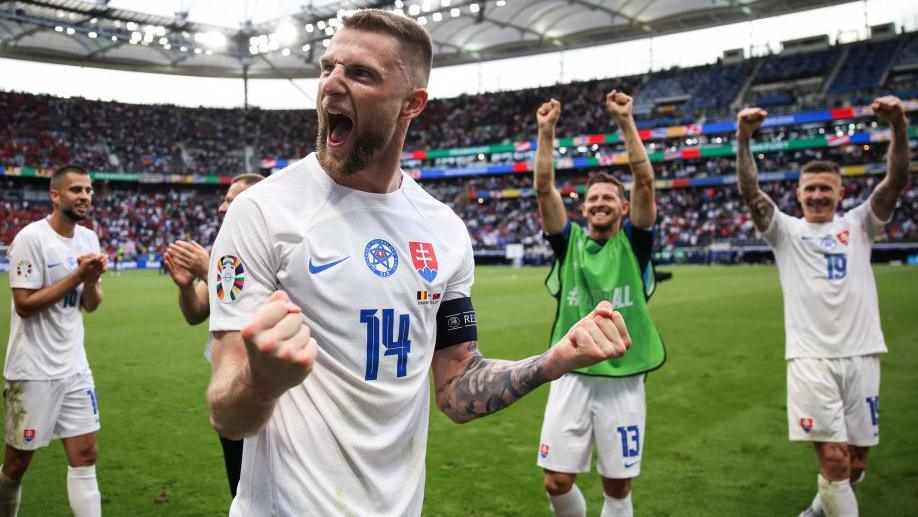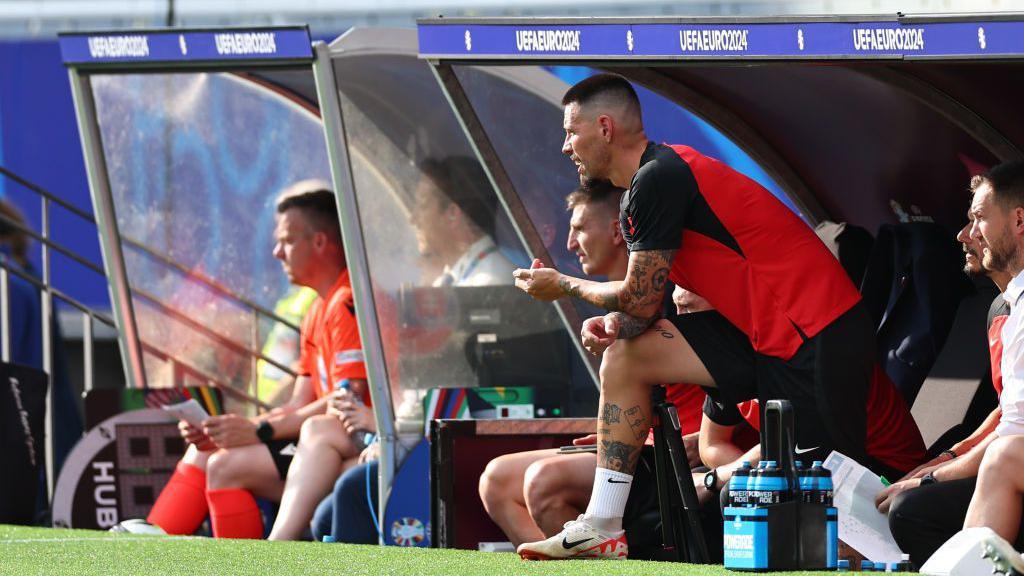Icon Hamsik, age factor and new tactics - Slovakia uncovered

Slovakia beat Belgium in their opening game of Euro 2024
- Published
The last time Slovakia reached the knockout stages of a European Championship they were swept aside 3-0 by Germany - but after beating Group F favourites Belgium at Euro 2024, the team's self-confidence is at an all-time high.
They believe they can surprise England in the last 16 in Gelsenkirchen on Sunday.
Slovakia are no footballing minnow. After all, Czechoslovakia won the European Championship in 1976 with a line-up formed largely by Slovak players.
However, reaching a European Championship quarter-final would be the biggest achievement for a country of 5.5m people since becoming independent in 1993.
The team, under Italian coach Francesco Calzona, set their sights on reaching the knockout stages and this tournament has many players at the peak of the career as they look to finally fulfil the expectations of Slovakia's fans.
The role of icon Hamsik

Marek Hamsik (kneeling) won 138 caps for Slovakia and is now assistant coach
There has arguably never been a better player in Slovakia’s history than Marek Hamsik.
The 36-year-old holds the record for the country's most appearances (138) and goals (26) and is also a legend at Serie A side Napoli.
He might now be retired, but Hamsik still plays a key role for Slovakia.
In July 2022, Slovakia were trying to find a new coach after a disastrous Nations League campaign during which they were beaten twice by Kazakhstan. With a lack of domestic coaches, the Slovak FA looked abroad but had a limited budget.
That is when Hamsik came in and recommended the largely unknown Calzona.
Calzona had never worked as a head coach previously, but he was Maurizio Sarri’s assistant and Hamsik knew him well from Napoli.
Calzona was appointed, much to the anger of some Slovak ex-players and fans, who had doubts because of his inexperience in a senior role.
It was also a revolutionary step because Slovakia had never had a foreign coach before other than Czech Pavel Hapal, who previously led Slovak club sides.
Hamsik helps out Calzona to this day.
He retired from football in May 2023 but returned one month later to play two more games in qualifying - against Liechtenstein and Iceland - after playmakers Ondrej Duda and Laszlo Benes were injured.
These days, Hamsik heads up his own football academy near Banska Bystrica but is also a member of Calzona’s staff as his assistant.
Calzona’s tactical revolution
He was mocked at the start - not least because some of his quotes in Italian were lost in translation - but Calzona’s spell has so far been successful.
In Euro 2024 qualifying, Slovakia suffered only two narrow defeats against Portugal, and were otherwise convincing. Calzona has managed to implement a clear tactical change.
Previously at big tournaments, as in their 0-0 draw against England at Euro 2016, Slovakia relied on a packed defence with counter-attacks, which were not too systematic.
However, Calzona set out to create a playing style that would suit the best Slovak players. He relies on a variation of 4-3-3 which works well especially because of the variability of the midfielders.
Stanislav Lobotka is a defensive midfielder who is also great at passing as well as breaking through the lines and being aware of what is going on around him. Juraj Kucka plays as a box-to-box midfielder while Duda, seen as Hamsik's successor, adds creativity.
Slovakia have become more open and adventurous, these days usually trying to play out from the back.
That works perfectly for Lobotka who, during the build-up, can also shift in between the two centre-backs, Denis Vavro and Milan Skriniar. Both are comfortable with ball at their feet, while adding solidity.
Left-back David Hancko is also a player to look out for.
He plays as a centre-back for Feyenoord but starts on the left for the national team and his strength lies in supporting the attack.
Slovakia have started to play with a higher defensive line, trying to press right up the pitch.
Calzona believes in an attacking style and managed to convince the players of his methods while creating a strong bond with them.
In February, he accepted an offer from his former club Napoli to coach them until the end of the season.
The Slovak FA agreed with this caretaker role, and Calzona signed a new contract with the national team until the end of 2025.
The oldest team at Euro 2024
After Calzona was appointed, there was a public demand for a generation change in the national team. Some of the older players retired - including Hamsik - but Calzona has a small pool of players to choose from.
That is why he still had to rely on older and experienced players in some positions. For example, right-back Peter Pekarik, 37, has 129 international caps and plays for Hertha BSC at club level.
However, Pekarik is still in a good form and has performed well at this tournament, neutralising Leandro Trossard in the opening win against Belgium.
Midfielder Kucka is only four months younger, but his obsession with eating well and a training programme has maintained his fitness levels so he can still face Europe's best.
In general, Slovakia has a relatively old team. This was visible during the qualifying campaign, when the average age of the starting line-up was almost 30, the highest of all the teams competing.
It is similar during Euro 2024; Slovakia's line-ups against Belgium and Ukraine had an average age of 30.7.
It is clear Calzona will need to rebuild soon and some younger players made it into his squad, such as Leo Sauer (Feyenoord, 18), Tomas Rigo (Banik Ostrava, 21), Tomas Suslov (Hellas Verona, 22) and Adam Obert (Cagliari, 21).
But there remains a problem at centre-forward, a position occupied at the moment by Robert Bozenik or David Strelec, with no talent pushing through.
Players spread across many leagues
Slovakia have players spread all over Europe, with the squad representing 12 different leagues, including the Premier League and Serie A.
It means players do not play with each other much at club level, although most of the key men have been playing for the national team for many years and have developed a good understanding.
Former Slovakia coach Jan Kozak complained he would like to build the side on the basis of good local clubs, but that is not currently possible.
Champions Slovan Bratislava provide just two players - Kucka and Strelec - and otherwise largely rely on foreigners, while other teams have to sell their best talent for profit.
Decent Slovak players often move to neighbouring countries such as the Czech Republic, Poland or Hungary.
However, all four starting defenders and goalkeeper Martin Dubravka are products of MSK Zilina, where they were taught a passing game that has enabled Slovakia to play in a different way.
A key mentality change
Previous Slovakia teams were often criticised and fans would only turn up in large numbers when the team had great results or faced a famous opponent.
Now, the interest in the team has grown, with TV viewership numbers for the game against England expected to be roughly in the same region as for the national ice hockey team, which is generally more popular.
While Slovakia were considered one of the outsiders before the tournament, players are confident and hoping to win the country over.
After the Belgium game, goalkeeper Dubravka said: "We all hope that we can make our whole nation proud."
In the last few years, Slovakia has been a politically divided country, but Dubravka appealed to his fellow citizens to be more confident in their football team.
"Maybe people criticise us and think we are not at the level of top football. But it's time to stop feeling like a small country and become more confident. That is also my challenge for people in Slovakia. We need to be on the same side," he added.
- Attribution